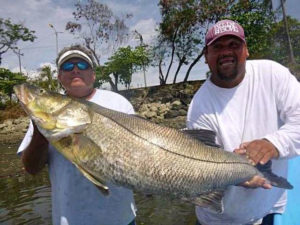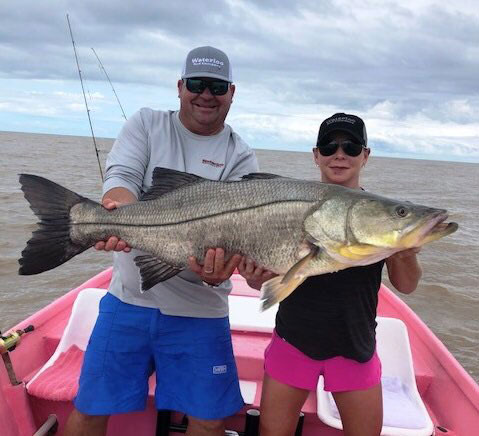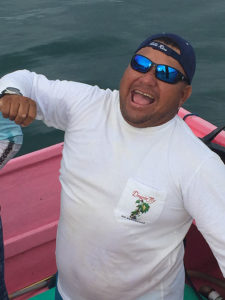FECOP Featured Sport Fishing Captain:
Roy Zapata – Snook King of Costa Rica’s Pacific Coast
Published for the Tico Times by Todd Staley
 Roy Zapata thinks like a fish. A really big fish. A big snook in fact. He has guided anglers to several world record snook over 50 lbs, the largest was Ward Michaels’s 60 lb fish, caught in March of 2014. He has 3 records in the book and a 51 lb fish caught last July by Whitney Thomas is pending verification from the International Game Fish Association as the new women’s world record.
Roy Zapata thinks like a fish. A really big fish. A big snook in fact. He has guided anglers to several world record snook over 50 lbs, the largest was Ward Michaels’s 60 lb fish, caught in March of 2014. He has 3 records in the book and a 51 lb fish caught last July by Whitney Thomas is pending verification from the International Game Fish Association as the new women’s world record.
Zapata comes from a long line of fishermen in Quepos. The oldest of seven siblings, his father left while he was still young, so he went from big brother to father figure, working and going to school. His uncles taught him how to fish. He began fishing at night as a handline artisanal fisherman, bringing his catch in at daybreak to sell at the dock. This allowed him time to attend to his brothers and sisters.
“I did that for almost 15 years and came in one morning with a boat load of snapper. There was this crazy gringo on the dock that said I want to fish with you. I explained I did not have the equipment or lures as I was a handline fisherman and he said he would buy them.” The “gringo” fished with him for a week. Zapata smiled as he recalled that the angler bought nearly 20 lures a day and lost many to toothy mackerel but also caught plenty of roosterfish and jacks and snapper and paid him almost $200 a day. That was the beginning of his charter career.

He continued to fish commercially and when he had a request he would take a tourist fishing. He was fishing snook commercially and doing quite well. The big snook he brought to the dock caught lots of attention and the line of sport anglers that wanted to charter him grew.
In the meantime, Marina Pez Vez was built in Quepos and one day Zapata took Harbor Master Carter Tackas fishing. Zapata told Tackas he wanted to start fishing tourists out of the marina. Tackas gave him some good advice. He had to get completely legal and have insurance to fish out of the marina. This meant he had to give up fishing commercially because in Costa Rica a boat can not hold a license to fish tourists and fish to sell your catch also.
“A fishing license to commercial fish was $40 dollars a year and the tourist license $400. Insurance is very expensive also, but I made the decision and now release most of my catch. (Tourist fishing boats are allowed 5 fish per day). I take very few snook these days.” He won Marina Pez Vela’s annual inshore fishing tournament three years in a row and decided not to fish last year. His younger brother who is also a snook guide won that tournament.
 His boat or as he describes it, “is my office, my machete, and my computer. It is my work tool.” The vessel is bare bones but very sea worthy and set up to fish where the big fish hang out. He has painted the interior of the boat bright pink. Most people think that is a bit strange but when people share photos of their catch, there is no mistake which boat they were fishing in. Quite the marketing strategy. The boat is also a powerful tiller driven motor which allows him to move quickly about the waves. The big snook hang at the breaking waves near shore.
His boat or as he describes it, “is my office, my machete, and my computer. It is my work tool.” The vessel is bare bones but very sea worthy and set up to fish where the big fish hang out. He has painted the interior of the boat bright pink. Most people think that is a bit strange but when people share photos of their catch, there is no mistake which boat they were fishing in. Quite the marketing strategy. The boat is also a powerful tiller driven motor which allows him to move quickly about the waves. The big snook hang at the breaking waves near shore.
I call it rodeo fishing. Zapata’s experience has made him an expert at timing waves. Getting your bait in the zone is a coordinated effort between him and his anglers to place the bait, in the zone. He prefers mullet or sardines. He sits behind the breaking waves watching the set. After the last wave from that set comes in, he races forward, and the anglers cast their baits. They free-spool line as he heads back outside before the next set of waves arrive, leaving the bait just where the big girls hang. He has success slow trolling baits on the back side of the breaks also.
You can catch a snook any day of the year, but he says March through June is the prime season. Two of his records came in late March and his last in early July. Near the new moon in March is when it starts, and many fish are taken between 20 and 30 lbs. When he notices the male snook he is catching are full of milk, (sperm) he knows the big females have arrived. From then on, there is a good chance at a really big fish. He had a fish much bigger than his 60 lb record that the hook pulled the hook next to the boat. A new record id out there.
Whitney Thomas hired him to catch roosterfish and after she had taken several asked if they could try for a snook. She hooked the fish on 15 lb test line and coaxed it for 45 minutes before they had the massive snook in the boat. For more information you can reach Zapata at +506 8505 5819 and a 6 hour charter is $400.
By Todd Staley published for the Tico Times print edition – Don’t forget to pick up your copy!
More Popular Fishing Articles
FECOP Featured Tarpon Fishing Captain, Eddie Brown
Sport fishing in Costa Rica: Where to Go, What You’ll Find
Costa Rica Fishing Species Tarpon AKA Silver King
The Fastest Growing Fish in The Ocean?
Costa Rica Marine Resources – Sport Fishing Isn’t The Problem





















